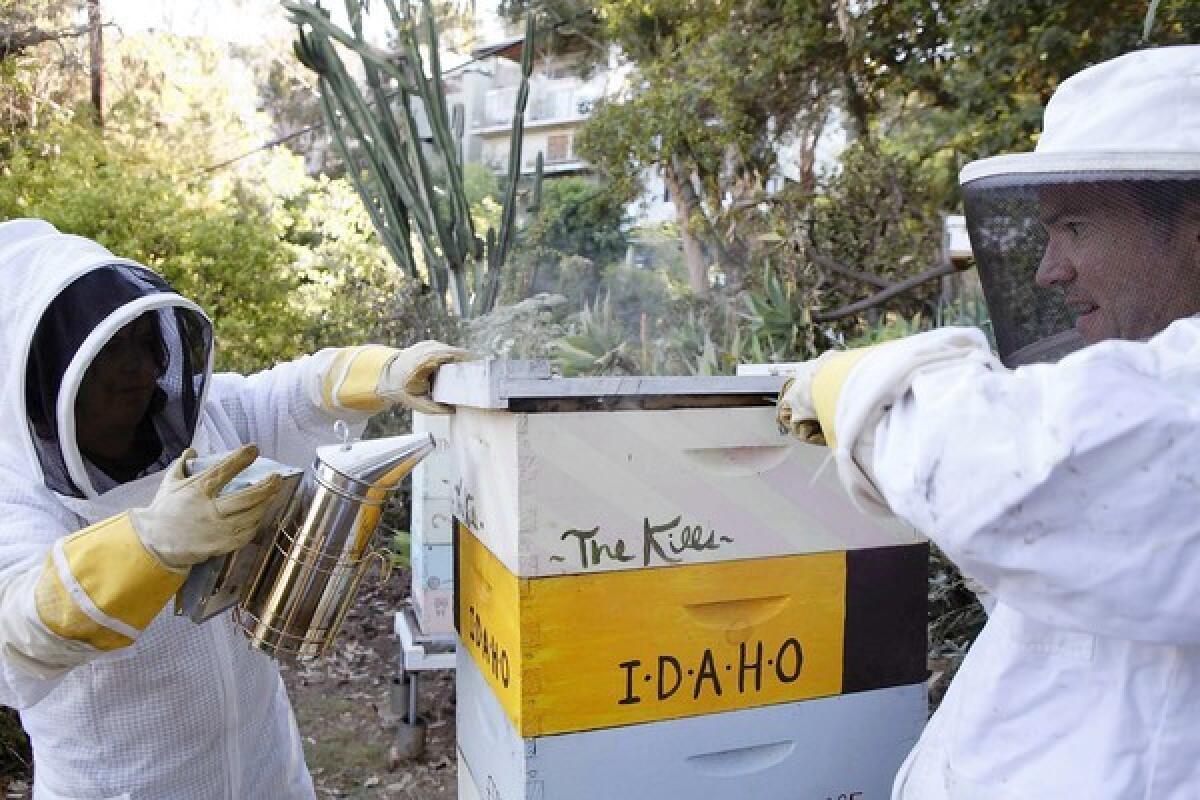It’s a sweet season for honey

- Share via
Roxana Jullapat, the pastry chef at Cooks County restaurant in West Hollywood, drizzles a spoonful of amber honey over a piece of honey-fig-walnut cake with roasted figs and burnt-honey ice cream. The honey she uses for the dessert, according to her menu, is Silver Lake honey, which, she says, often prompts the question from customers: “Are the bees hipsters who hang out at Intelligentsia drinking coffee and wearing skinny jeans?”
Actually, they’re honey bees who reside on an east Silver Lake hill in the backyard of Amy Seidenwurm and Russell Bates, drinking the nectar of the flowers of lavender, California buckwheat, sage, jasmine and eucalyptus, fig and citrus trees. (A nod to hipsterdom: Their wooden stacked-box hives are decorated with the names of bands such as Hüsker Dü, the Jam and Idaho.)
This season the couple’s bees — about 120,000 of them in three hives — have produced more than 60 pounds of honey, twice as much honey as in past years. “We’ve never had this much of it,” says Seidenwurm, whose honey and honeycomb go to Bar Covell wine bar in Los Feliz for its charcuterie plates and Village Bakery in Atwater, where it garnishes fruit crostatas and is sold in jars under the label Feral Honey & Bee. Cooks County puts the honeycomb on its cheese plates, and Jullapat pours honey on her melon sorbets or chocolate-filled beignets. “I love the combination of chocolate and honey,” she says.
Other urban beekeepers have been flush with honey too. Kirk Anderson, who along with Seidenwurm and Bates founded the progressive apiculture group Backwards Beekeepers, recently dropped off nearly 100 jars of his honey at Lindy & Grundy, the organic butcher shop on Fairfax Avenue. Anderson tends bees all over Los Angeles, and this is the latest haul of Kirk’s Local Honey from hives in Studio City.
“I can taste the difference between Bel-Air, Altadena and Los Feliz,” says Lindy & Grundy co-owner Amelia Posada. “This is the first time we’ve had Studio City honey.”
Overall, it’s been a bumper season for urban honey in L.A., and summer is when worker bees are at their busiest. Corey Brill has three hives on a rooftop downtown and sells his Old Bank Honey to stores including Coffee Commissary on Fairfax. He says he harvested at least 50% more honey this year than last year.
“We’d like to take the credit” for the bonanza of honey, says Seidenwurm of Feral Honey & Bee, standing in a three-layer protective suit and pulling a frame bulging with honeycomb from one of the quintuple-level hives as hundreds of bees buzz around her. “But they do all the work. We just steal from them.”
“Silver Lake treats bees really well,” says Bates. “There’s a huge variety [of plants] that blooms everywhere,” and bees travel as far as five miles to collect nectar that they convert into honey.
The key to all that nectar was spring rain, says Anderson, considered a guru who promotes organic, treatment-free beekeeping. “Just the right amount of rain and the right amount of sun,” he says. “It’s been a good year, maybe one in every eight or nine years there’s a bumper crop.”
The growing amount of neighborhood honey is also helped by an increasing interest in beekeeping. The Backwards Beekeepers started with a handful of members three years ago; now each of its monthly meetings draws more than 100 people.
“We started [beekeeping] because we wanted to do something that allowed us to create our own food, to be closer to the process,” says Seidenwurm, who also raises chickens in her and Bates’ quarter-acre yard.
Though the city of Los Angeles doesn’t allow hives in residential zones, many keep bees under the radar, and a grass-roots movement to change the law has drawn the support of nearly a dozen neighborhood councils. That’s at least partly because of the growing concern about colony collapse disorder. Cities such as New York, Seattle, San Francisco and Santa Monica allow residential beekeeping.
Meanwhile, the demand for neighborhood honey is high. “We’re always asking Kirk for more,” says Lindy & Grundy’s Posada. “We usually get about 20 jars at a time and sell out of it in a matter of days.” (And though the honey season has been swell, it’s still highly allocated stuff.)
The big draw, besides eating über-locally? It’s like wine, says Old Bank Honey’s Brill. “That’s the neat thing. Every time you harvest the honey, it’s different, a different taste, a different color, depending on what the bees have been eating.”
Seidenwurm of Feral Honey & Bee says her honey is “sometimes floral, or caramely and funky, sometimes it’s darker, or sometimes it’s thicker. Lately it tastes a lot to me like the jasmine that was blooming for a long time.”
Where to buy local honey
Feral Bees & Honey
Village Bakery, 3119 Los Feliz Blvd., Los Angeles, (323) 662-8600, https://www.thevillagebakeryandcafe.com. Also served at: Bar Covell, 4628 Hollywood Blvd., Los Angeles, (323) 660-4400, and Cooks County, 8009 Beverly Blvd., Los Angeles, (323) 653-8009, https://www.cookscountyrestaurant.com.
Kirk’s Local Honey
Lindy & Grundy, 801 N. Fairfax Ave., Los Angeles, (323) 951-0804, https://www.lindyandgrundy.com; Cheese Store of Silver Lake, 3926 W. Sunset Blvd., Los Angeles, (323) 644-7511, https://www.cheesestoresl.com. Also online at https://www.kirkslocalhoney.com.
Old Bank Honey
Coffee Commissary, 801 N. Fairfax Ave., #106, Los Angeles, (323) 782-1465, https://www.coffeecommissary.com; Old Bank District Market, 409 S. Main St., Los Angeles, (213) 680-9000.
Call for availability.
Betty Hallock
More to Read
Eat your way across L.A.
Get our weekly Tasting Notes newsletter for reviews, news and more.
You may occasionally receive promotional content from the Los Angeles Times.










